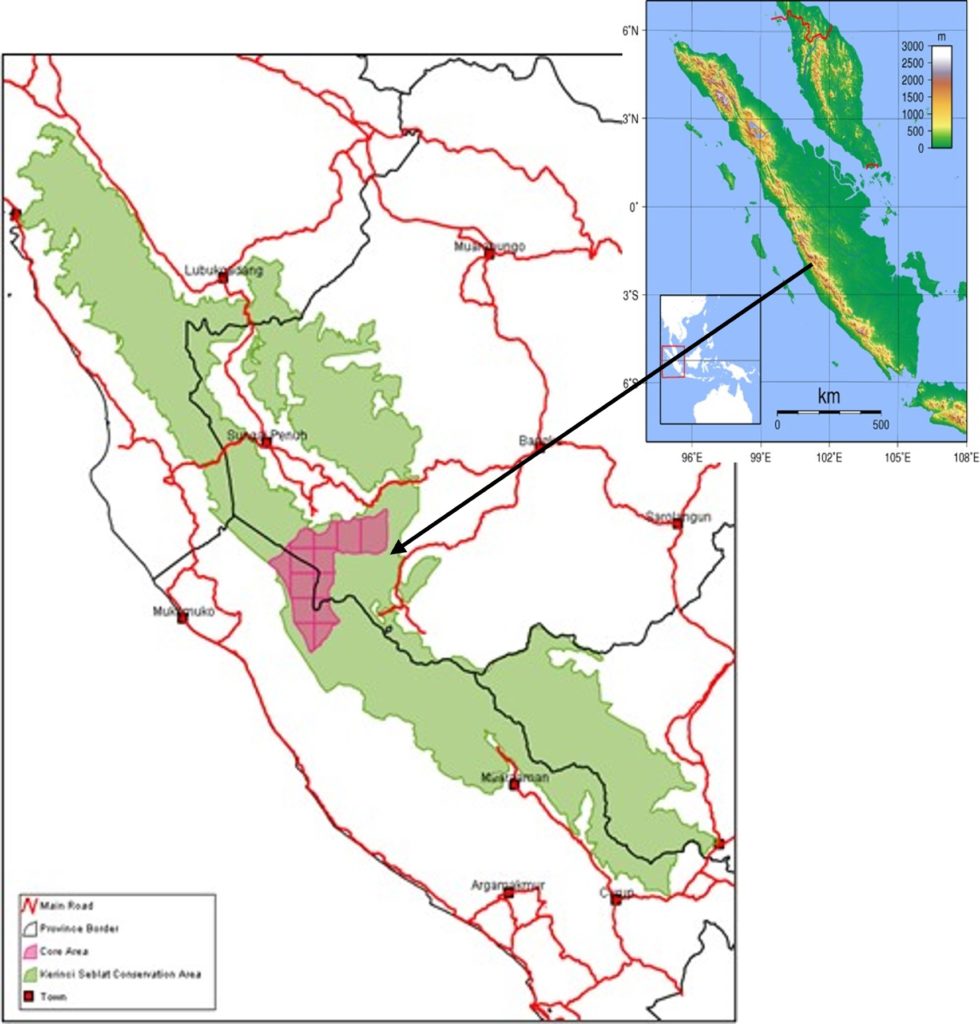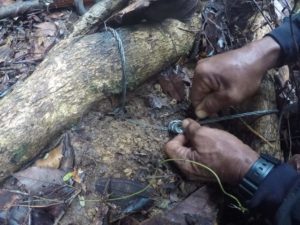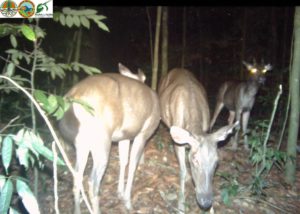Is tiger density increasing in the core area of Kerinci Seblat National Park?
A team of highly-committed rangers protect Sumatran tigers and other key species across Kerinci Seblat National Park in Indonesia. In the last 5 years, the number of snares discovered by the rangers has fallen by 56% because of intelligence-driven patrols, using best practice data collection and analysis techniques.
Landscape wide, the percentage of Tiger Protection and Conservation Unit (TPCU) patrols reporting tiger presence rose from 62% in 2020 to 68% in 2021 (the highest recorded) and the “Frequency of Encounter” with tigers that patrols recorded was stable at 1 tiger per 18.3km following three years of increasing encounter rates. Evidence of two tiger family groups was also reported with a total of three new cubs. A record 95% of patrols in the Core Area reported tigers present.
The number of tigers estimated to live within the park may well be increasing. However, as the most recent report from the field team reminds us, COVID-19 has prevented the latest camera trap surveys from taking place which could back up this evidence. Once the team are able to conduct the population monitoring survey, we can get a better understanding of this crucial population of Sumatran tigers.

What are the factors influencing the number of tigers in Kerinci Seblat National Park?
The Positive Influences on Tiger Numbers
1. Declining numbers of tiger snares
Last year we saw a 141% decrease in the detection rate of snares compared to the long-term park average. However, we cannot become complacent. A total of six ‘recently-active’ tiger snares were reported by rangers on patrols, two in the west of the national park and one in the east. Read more about how snares are indiscriminately killing tigers below.

Dismantling an active tiger snare ©FFI/KSNP
2. Evidence of a decline in deer poaching and a gradual increase in prey numbers
The threat to key tiger prey species from poaching has fallen and remains low.
As a result, we are seeing an increase in the abundance of deer (primarily rusa sambar and muntjak) in the Tiger Core Area. An increase in prey species is important to support a growing tiger population. Only one ‘long’ snare line for deer was recorded and destroyed on an information-led patrol during the fasting month of Ramadan in 2021, a time of traditionally high poaching rates. Snares are also set to trap both deer and pigs by farmers who are losing crops to marauders. But traps are indiscriminate and tigers and other species can get caught in them causing life-changing injuries and often death.

Sambar Deer © FFI/KSNP
3. Successful investigations and information-led patrols
Information-led TPCU patrols draw on support from forest-edge farmers and others within the local community. Using local knowledge is estimated to increase snare detection by up to 40% and plays an important role in investigating poaching and wildlife crime. Investigations by this project have led to the arrest and prosecution of over 70 tiger poachers or traders in four provinces of Sumatra since 2000. Many investigations are carried out by painstakingly piecing together intelligence collected over a long period of time, involving many different stakeholders including the park edge and provincial police of the four provinces that border the park.
In 2021, more than 30 investigations were conducted; two of which secured first-hand evidence, with one of these investigations proceeding to an operation led by the Ministry of Environment and Forestry Law Enforcement. Formal, written warnings or verbal cautions and instructions to leave the national park were issued to 18 men during 12 patrols for a range of offences including illegal logging and hunting wild songbirds to supply the lucrative cagebird trade. Two chainsaws and a high-powered rifle, found in a forest-edge farmhouse, were confiscated while bird hunting equipment was confiscated from offenders encountered within the national park.
Protection of this National Park by the TPCU benefits not just tigers but contributes to the balance of a healthy ecosystem protecting all the plants and animals that share this habitat.

Tiger law enforcement June 2021 © KSNP

Guns confiscated by the TPCU in July 2021 © FFI/KSNP
Negative influences on the Sumatran tiger population
1. Illegal logging
Sumatran tigers in Kerinci Seblat continue to face a range of threats, not least habitat loss both within and adjoining the protected area. Illegal logging, generally local and small-scale in nature, was recorded on 13% of patrols in or immediately adjoining the national park during 2021 with ranger patrols responding where possible. Smallholder encroachment into the National Park or buffer-zone forests continued to pose the most widely encountered threat to tigers, with crops such as coffee and oil palm.

Illegal forest clearance in KSNP for coffee growing © FFI
2. Large Scale Infrastructure Projects
Road development is a threat to wild tiger populations across their whole range as roads cut across their habitat. They disrupt male and female connectivity and so breeding, increase road traffic accidents and make it easier for poachers to enter a forest area. Roads are the inevitable result of other infrastructure projects that require transportation, such as oil palm processing mills. In one area to the south of the Kerinci valley, disturbingly high rates of encroachment were recorded in an area where there is pressure for a road to be constructed to serve a proposed geothermal power development plant.

Road building in a Sumatran forest © R Willers
3. Resumption of international demand and trade routes after Covid-19
Covid-19 has had an impact on illegal trade routes and the ability of poachers and traders to travel. However. international travel restrictions imposed as a result of the pandemic are now being widely eased and tourism is slowly resuming. The team will be watching closely for any significant changes in demand for tiger products, particularly for tiger canines. This could quickly undermine the gains that have been made in reducing tiger poaching in the area.

Each tiger poached is a devastating loss to the population © FFI/KSNP 2021
4. Disease
The real threat from African Swine Fever (ASF) is now believed to be impacting wild boar populations which form a core tiger prey species. ASF is currently in around 51 countries around the world and is having major economic impacts on the domestic pork industry. You can find out more about the threat in our blog Are we making tigers and their prey sick? Pt. 1 African Swine Fever. following the WildCats Pawcast interview with Dr Matthew Linkie, the Indonesia Deputy Country Director for the Wildlife Conservation Society (WCS) and the Asia Coordinator for the IUCN/SSC Wild Pig Specialist Group.

Wild pigs can catch African Swine Fever
5. Financial insecurity
Tigers are becoming increasingly exposed to human pressures as government funding of protected areas is redirected to COVID-relief operations. We have seen in the latest report that some conservation activities could not be carried out due to a lack of funding.
The report says –
The number of patrols conducted, forest patrol days and distance walked was substantially lower than planned due to severe financial constraints on all TPCU rangers field activities in the second half of the project period as a result of shortfalls and delays in disbursement of anticipated counterpart funding.

Without funds, simple items like boots are harder to replace. © R Willers
You can help support the Tiger Protection and Conservation Unit rangers protect Sumatran tigers in 2023 by donating now.
How you can help
Support our work
Stay in touch
 Sign up for our e-newsletter to get the latest conservation updates and learn about ways you can help.
Sign up for our e-newsletter to get the latest conservation updates and learn about ways you can help.


